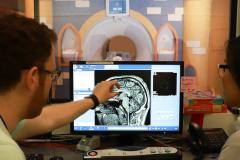- Overview
-
The Naturalistic Neuroimaging Lab uses movies to study complex patterns of brain function in child psychiatric disorders. Using movies helps us study children who have a hard time staying still inside the MRI machine. The movies also enable us to study the brain as it processes complex, dynamic streams of information like it does in real life. This approach is similar to having a patient run on a treadmill while studying that person's heart function. We design and test movies to evoke specific symptoms or types of cognitive processes, and are developing novel analyses to leverage the unique kind of data we acquire using movies in functional MRI.
- Publications
-
Minimal Variation in Functional Connectivity in Relation to Daily Affect
eneuro
Kate J. Godfrey and Shefali Rai and Kirk Graff and Shelly Yin and Daria Merrikh and Ryann Tansey and Tamara Vanderwal and Ashley D. Harris and Signe Bray
DOI: 10.1523/ENEURO.0209-24.2024
12/2024Mapping patterns of thought onto brain activity during movie-watching
Raven S Wallace and Brontë Mckeown and Ian Goodall-Halliwell and Louis Chitiz and Philippe Forest and Theodoros Karapanagiotidis and Bridget Mulholland and Adam G Turnbull and Tamara Vanderwal and Samyogita Hardikar and Tirso Gonzalez Alam and Boris Bernhardt and Hao-Ting Wang and Will Strawson and Michael Milham and Ting Xu and Daniel Margulies and Giulia L Poerio and Elizabeth Jefferies and Jeremy I Skipper and Jeffery Wammes and Robert Leech and Jonathan Smallwood
DOI: 10.7554/eLife.97731.3
11/2024WHAT’S THE BIG DEAL?: EMERGING THEMES IN CHILD AND ADOLESCENT PSYCHIATRIC NEUROIMAGING RESEARCH
Journal of the American Academy of Child & Adolescent Psychiatry
Tamara Vanderwal
DOI: 10.1016/j.jaac.2024.07.832
10/2024Using fingerprinting as a testbed for strategies to improve reproducibility of functional connectivity
Jivesh Ramduny and Tamara Vanderwal and Clare Kelly
DOI: 10.1101/2024.06.21.599225
06/2024Data rescue in high-motion youth cohorts for robust and reproducible brain-behavior relationships
Jivesh Ramduny and Tamara Vanderwal and Clare Kelly
DOI: 10.1101/2024.06.04.597447
06/2024Increasing the representation of minoritized youth for inclusive and reproducible brain-behavior associations
Jivesh Ramduny and Lucina Q. Uddin and Tamara Vanderwal and Eric Feczko and Damien A. Fair and Clare Kelly and Arielle Baskin-Sommers
DOI: 10.1101/2024.06.22.600221
06/2024Subgenual cingulate connectivity as a treatment predictor during low-frequency right dorsolateral prefrontal rTMS: A concurrent TMS-fMRI study
Brain Stimulation
Vinh Tan and Jerrold Jeyachandra and Ruiyang Ge and Erin W. Dickie and Elizabeth Gregory and Tamara Vanderwal and Fidel Vila-Rodriguez and Colin Hawco
DOI: 10.1016/j.brs.2023.07.051
07/2023Cortical gradients during naturalistic processing are hierarchical and modality-specific
NeuroImage
Ahmad Samara and Jeffrey Eilbott and Daniel S. Margulies and Ting Xu and Tamara Vanderwal
DOI: 10.1016/j.neuroimage.2023.120023
05/2023Getting the nod: Pediatric head motion in a transdiagnostic sample during movie- and resting-state fMRI
PLOS ONE
Simon Frew and Ahmad Samara and Hallee Shearer and Jeffrey Eilbott and Tamara Vanderwal
DOI: 10.1371/journal.pone.0265112
04/2022Naturalistic imaging: The use of ecologically valid conditions to study brain function
NeuroImage
Emily S. Finn and Enrico Glerean and Uri Hasson and Tamara Vanderwal
DOI: 10.1016/j.neuroimage.2021.118776
02/2022Fractal-Based Analysis of fMRI BOLD Signal During Naturalistic Viewing Conditions
Frontiers in Physiology
Olivia Campbell and Tamara Vanderwal and Alexander Mark Weber
DOI: 10.3389/fphys.2021.809943
01/2022Stability and similarity of the pediatric connectome as developmental measures
NeuroImage
Tamara Vanderwal and Jeffrey Eilbott and Clare Kelly and Simon Frew and Todd S. Woodward and Michael P. Milham and F. Xavier Castellanos
DOI: 10.1016/j.neuroimage.2020.117537
02/2021Towards clinical applications of movie fMRI
NeuroImage
DOI: 10.1016/j.neuroimage.2020.116860
08/2020ADHD desynchronizes brain activity during watching a distracted multi-talker conversation
NeuroImage
DOI: 10.1016/j.neuroimage.2019.116352
11/2019The Functional Brain Organization of an Individual Allows Prediction of Measures of Social Abilities Transdiagnostically in Autism and Attention-Deficit/Hyperactivity Disorder
Biological Psychiatry
Evelyn M.R. Lake and Emily S. Finn and Stephanie M. Noble and Tamara Vanderwal and Xilin Shen and Monica D. Rosenberg and Marisa N. Spann and Marvin M. Chun and Dustin Scheinost and R. Todd Constable
DOI: 10.1016/j.biopsych.2019.02.019
08/2019Shared understanding of narratives is correlated with shared neural responses
NeuroImage
Mai Nguyen and Tamara Vanderwal and Uri Hasson
DOI: 10.1016/j.neuroimage.2018.09.010
01/2019Movies in the magnet: Naturalistic paradigms in developmental functional neuroimaging
Developmental Cognitive Neuroscience
Tamara Vanderwal and Jeffrey Eilbott and F. Xavier Castellanos
DOI: 10.1016/j.dcn.2018.10.004
11/2018The Variability of Neural Responses to Naturalistic Videos Change with Age and Sex
eneuro
Agustin Petroni and Samantha S. Cohen and Lei Ai and Nicolas Langer and Simon Henin and Tamara Vanderwal and Michael P. Milham and Lucas C. Parra
DOI: 10.1523/ENEURO.0244-17.2017
01/2018Individual differences in functional connectivity during naturalistic viewing conditions
NeuroImage
Tamara Vanderwal and Jeffrey Eilbott and Emily S. Finn and R. Cameron Craddock and Adam Turnbull and F. Xavier Castellanos
DOI: 10.1016/j.neuroimage.2017.06.027
08/2017The Healthy Brain Network Serial Scanning Initiative: a resource for evaluating inter-individual differences and their reliabilities across scan conditions and sessions
GigaScience
David O’Connor and Natan Vega Potler and Meagan Kovacs and Ting Xu and Lei Ai and John Pellman and Tamara Vanderwal and Lucas C. Parra and Samantha Cohen and Satrajit Ghosh and Jasmine Escalera and Natalie Grant-Villegas and Yael Osman and Anastasia Bui and R. Cameron Craddock and Michael P. Milham
DOI: 10.1093/gigascience/giw011
01/2017Age and sex modulate the variability of neural responses to naturalistic videos
Agustin Petroni and Samantha Cohen and Lei Ai and Nicolas Langer and Simon Henin and Tamara Vanderwal and Michael P. Milham and Lucas C. Parra
DOI: 10.1101/089060
11/2016Polypharmacy in Attention-Deficit/Hyperactivity Disorder: More Than the Sum of Its Parts?
Journal of the American Academy of Child & Adolescent Psychiatry
Tamara Vanderwal
DOI: 10.1016/j.jaac.2016.04.021
08/2016Inscapes: A movie paradigm to improve compliance in functional magnetic resonance imaging
NeuroImage
Tamara Vanderwal and Clare Kelly and Jeffrey Eilbott and Linda C. Mayes and F. Xavier Castellanos
DOI: 10.1016/j.neuroimage.2015.07.069
11/2015Of Bandwagons and Bathwater: The Value of Resting State Functional Magnetic Resonance Imaging for Child Psychiatric Research
Journal of the American Academy of Child & Adolescent Psychiatry
Tamara Vanderwal and Clare Kelly and F. Xavier Castellanos
DOI: 10.1016/j.jaac.2013.03.004
06/2013Self, mother and abstract other: An fMRI study of reflective social processing
NeuroImage
Tamara Vanderwal and Elinora Hunyadi and Daniel W. Grupe and Caitlin M. Connors and Robert T. Schultz
DOI: 10.1016/j.neuroimage.2008.03.058
07/2008 - Research
-
Grants
"Brain Mapping of Discrete Developmental Periods", American Psychiatric Association/Lilly Psychiatric Research Fellowship
“The use of movies to assay brain network dynamics in ADHD”, Klingenstein Family Foundation
"Intrinsic Connectivity Networks in Young Children", American Academy of Child and Adolescent Psychiatry
"Developmental Trajectories of Intrinsic Functional Connectivity", Allison Family Foundation
Honours & AwardsAmerican Academy of Child and Adolescent Psychiatry Junior Investigator Award
Resident Teaching Award, Department of Psychiatry, Yale School of Medicine
Contributing Editor (2014-2017), The Journal of the American Academy of Child and Adolescent Psychiatry
Yale Psychiatry Research Scholar, Yale School of Medicine
Research Group MembersNurullah Buker, Research volunteer
Byung Hoon Choi, Graduate Student
Tara Gaertner, Psychiatry Research Resident
Kaya Horii, Volunteer Research Assistant
Jacqueline Lee, Graduate Trainee
Eduard Popescu, Research Assistant
Ahmad Samara, Graduate Student
Ashan Veerakumar, Clinical Trainee
Screen time for science: New investigator Dr. Tamara Vanderwal uses movies to explore the inner-workings of children’s brains
For Dr. Tamara Vanderwal, movies are more than just a fun distraction for kids. She’s using movies as an innovative tool to see how the developing brain processes information. Her work could improve the way doctors diagnose and treat mental illness in children, leading to better outcomes for kids with these chronic, life-altering conditions.






